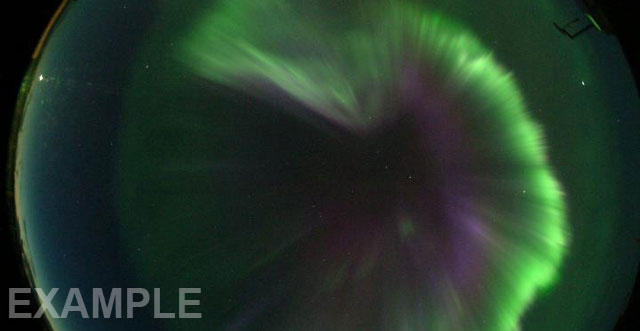National Aeronautics and Space Administration
Goddard Space Flight Center

Space Weather Action Center
Auroras
Kiruna All-Sky Camera Tutorial:
Getting to the Data:
You can quickly get to the "Aurora" section of Space Weather Resource page. Simply click on the 'Live data' link under "Kiruna All-Sky Camera".
The 'Kiruna All-sky Camera' web page refreshes automatically every minute.
About the Data:
An all-sky camera has been operating in Kiruna since the International Geophysical Year in 1957 (Stoffregen, 1962). In 1977 the camera was replaced with a new more automated type. The new digital all-sky camera in Kiruna is based on a commercial digital camera with replaceable optics. The camera is controlled by a camera control computer and the image data is transferred to an archiving computer, where it is made available to the world-wide web. (a 1 -2 day delay)

Sample Image: 2005-04-11 22.53
Swedish Institute of Space Physics (IRF), Head Office, Kiruna.
THE ABOVE IMAGE IS NOT LIVE DATA.
The sky is imaged onto a convex mirror, which is photographed by the 16 mm film camera located above the mirror. This design results in a loss of information in Zenith. The film camera is controlled by electronics, which exposes the camera at a selected interval; (typically once every minute) synchronizes the exposures with UTC, (using GPS) and advances the film, etc. Typical exposure time is 4 seconds, but every eighth exposure is four times longer, in order to reveal faint auroras. When the camera is not in use, or during heavy snowfall, a cover automatically closes and protects the mirror. An electrical heater keeps the mirror free of moist.
Aurora Viewing Tips
- For more information on Aurora forecasting and the best times to view Aurora in the Northern Summer, visit http://www.gedds.alaska.edu/AuroraForecast/ .The forecasts deal with the average level of activity expected within the prediction period. The sun occasionally produces bursts of unforeseen intensity, so the most spectacular auroral displays can come with little warning.
- Aurora viewing is affected by a variety of other factors, such as cloud cover, moonlight, and urban light pollution. The most active auroras form near local midnight and come in waves, these are referred to as sub-storms. It is not unusual even during an active storm to have a lull in activity that becomes intense within an hour. Auroral forms are more than 80 km (55 miles) above the earth, so they can be seen from as far as 400 km (250 miles) away.
Analysis Tips:
- Use the data from the Kp index and the ACE satellite to determine the best possibility of seeing aurora. The POES satellite will show the location and intensity of the storm from space.
Navigation Tips
- When visiting the Kiruna All-Sky camera website be sure to view the Kiruna All-Sky "Slide" Show!
- Don't forget to record the exact date and time of the image found at the top of the webpage. Checking the date and time of the image is important because the images are not updated if viewing conditions are poor.
About the Swedish Institute of Space Physics (IRF)
IRF was originally named the Kiruna Geophysical Observatory (KGO), and was established in 1957 by the Royal Swedish Academy of Sciences. In 1973 KGO became an independent research institute, and was renamed the Kiruna Geophysical Institute (KGI). KGI was renamed the Swedish Institute of Space Physics in 1987. The research activities at IRF in Kiruna concern studies of phenomena in the Earth's upper atmosphere, the ionosphere, and planetary magnetospheres. Ground-based measurements of ionospheric parameters, the geomagnetic field, optical aurora, and radio wave propagation.
You are viewing a tutorial
Related Tutorials
The above tutorials compliment the downloadable Flip Charts and Data Sheets.
